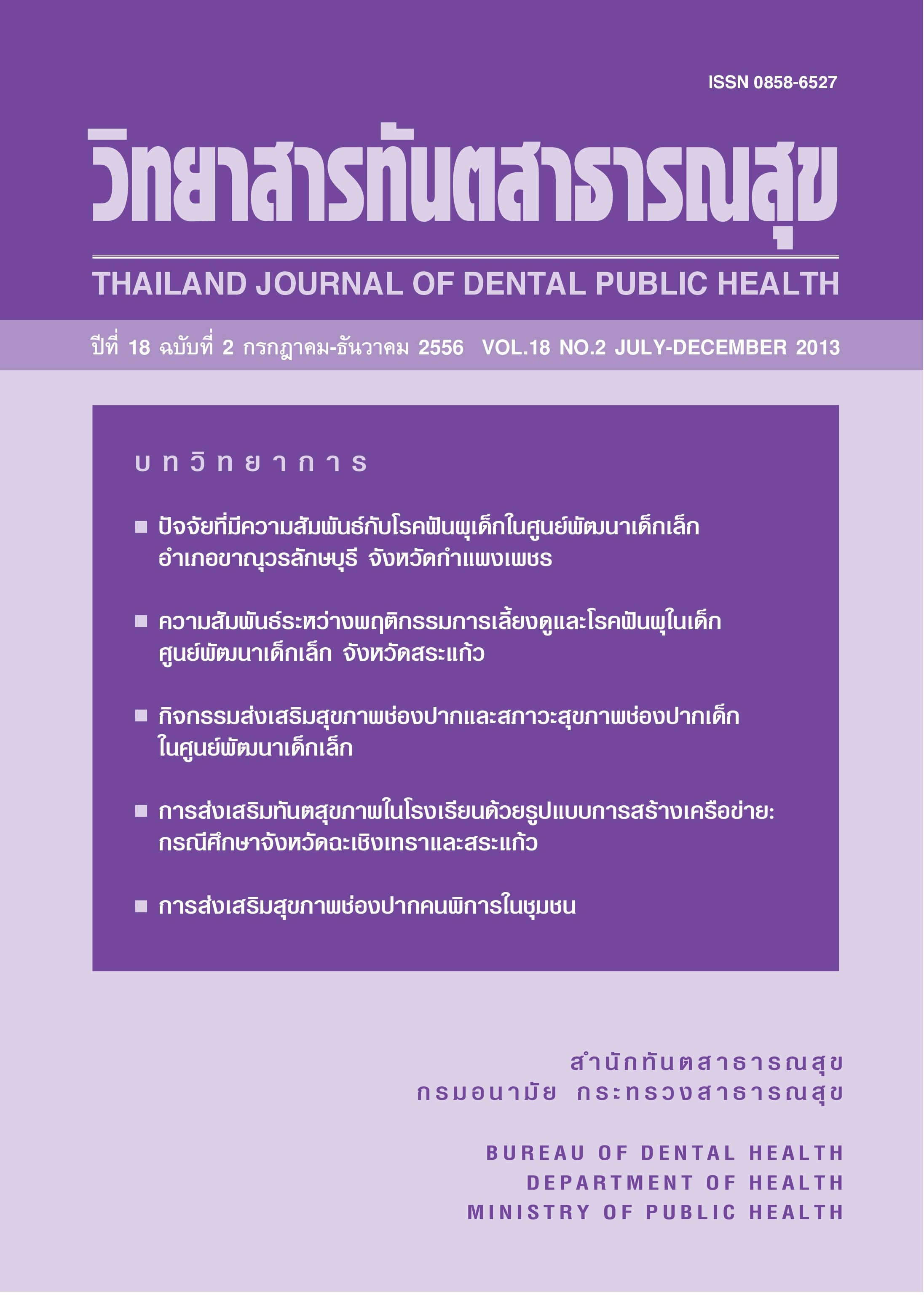Oral Health Promoting by School Networking : Case Study in Chachoengsao Province and Sa Kaeo Province
Main Article Content
Abstract
Beautiful Smiles in Eastern School Network (BSES) is a project that promotes oral health activities in primary schools. This study was aimed to compare oral health promotion in schools before processing, implementation and after action and students oral health status. The target areas were Chachoengsao and Sa Kaeo Province. Twelve primary schools were selected from two schools per network and three networks per provinces by simple random sampling. The processes were assessed by observing, interviewing, and checking implementation documents. The outcomes were assessed by checking oral health status, personal hygiene and interviewing oral health care behaviors. The results were found that the scores of oral health promotion policy assignments, dental health education integration, the controlling of eating foods causing tooth decay and dental plague management significantly increased every year. There was only the proportion of brushing teeth before going to bed that increased and the average of candy eating times which decreased.
Downloads
Article Details
References
2. ขนิษฐ์รัตนรังสิมา, ปิยะดา ประเสริฐสม และวรรณภา ศรีทอง. สภาวะสุขภาพช่องปากเด็กประถมศึกษาและปัจจัยที่เกี่ยวข้องจากระบบเฝ้าระวังทันตสุขภาพ ระหว่างปี 2548 – 2553. ว.ทันต.สธ. 2554; 16(1), 17 – 32.
3. รุจเรขา วิทยาวุฑฒิกุล และน้ำทิพย์ วิภาวิน. การวิเคราะห์เครือข่ายทางสังคม กับงานวิจัยทางสารสนเทศศาสตร์. วารสารบรรณศาสตร์ มศว. 2555; 5(2), 126 – 140.
4. เกษม นครเขตต์. เอกสารวิชาการ แนวคิดและทฤษฎีเครือข่ายทางสังคม. วันที่ 21 มีนาคม 2555. [ระบบออนไลน์]. แหล่งที่มาhttp://www.thaindc.org/images/column_1325143518/Social%20 Network % 20Theory %20Dr_Kasem.pdf.
5. Fejeskov O. Changing paradigms in concepts on dental caries : consequences for oral health care. Caries Res 2004; 38, 182 – 191.
6. Thomson WM and Mackay TD. Child dental caries patterns described using a combination of area-based and household-based socio-economic status measures. Community Dental Health 2004 ; 21, 285 – 290.
7. Chankanka O, Marshall TA, Levy SM, Cavanaugh JE, Warren JJ, Broffitt B, et al. Mixed dentition cavitatedcaries incidence and dietary intake frequencies. Pediatr Dent. 2011 May-Jun;33(3):233-40.
8. Guido JA, Martinez Mier EA, Soto A, Eggertsson H, Sanders BJ, Jones JE, et al.Caries prevalence and its association with brushing habits, water availability, and the intake of sugared beverages.Int J Paediatr Dent. 2011 Nov;21(6):432-40. Epub 2011 Jul 1.
9. Pradhan D, Jain D, Gulati A, Kolhe SJ, Baad R, Rao BS. Effect of the Presence of Dental Plaque on Oral Sugar Clearance and Salivary pH: An in vivo Study.J Contemp Dent Pract. 2012 Nov 1;13(6):753-5.
10. รวี เถียรไพศาล. แบคทีเรียและโรคติดเชื้อที่พบบ่อยในช่องปาก. พิมพ์ครั้งที่ 1, ไอคิว มีเดีย: สงขลา, 2552.
11. Moslehzadeh K. Oral hygiene index (Greene and Vermilion, 1960) (25 Mar 2013) Online Available from : http://http://www.mah.se/CAPP/Methods-and-Indices/Oral-Hygiene-Indices /Oral-Hygiene-Index-Greene-and-Vermilion-1960-/
12. Maltz M, Jardim JJ, Alves LS. Health promotion and dental caries.Braz Oral Res. 2010;24Suppl 1:18-25.
13. Jodkowska E. Efficacy of pit and fissure sealing: long-term clinical observations. Quintessence Int. 2008 Jul-Aug;39(7):593-602.
14. ClaydonNC.Current concepts in toothbrushing and interdental cleaning.Periodontol 2000. 2008;48:10-22.
15. Jaghasi I, Hatahet W, DashashM.Dietary patterns and oral health in schoolchildren from Damascus, Syrian Arab Republic. East Mediterr Health J. 2012 Apr;18(4):358-64.


